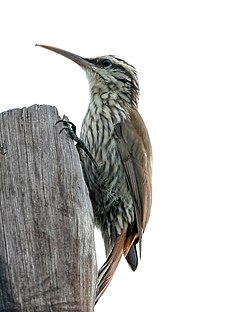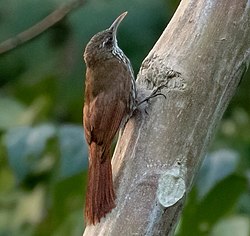| Image | Scientific name | Common name | Distribution |
|---|
 | Lepidocolaptes leucogaster | White-striped woodcreeper | Mexico. |
 | Lepidocolaptes souleyetii | Streak-headed woodcreeper | southern Mexico to northwestern Peru, northern Brazil and Guyana, and also on Trinidad. |
 | Lepidocolaptes angustirostris | Narrow-billed woodcreeper | Argentina, Bolivia, Brazil, Paraguay, Suriname, and Uruguay. |
 | Lepidocolaptes affinis | Spot-crowned woodcreeper | central Mexico in the east, the Sierra Madre Orientals, to northern Panama. |
 | Lepidocolaptes lacrymiger | Montane woodcreeper | Bolivia, Colombia, Ecuador, Peru, and Venezuela. |
 | Lepidocolaptes squamatus | Scaled woodcreeper | Brazil. |
 | Lepidocolaptes falcinellus | Scalloped woodcreeper | southeastern Brazil, eastern Paraguay and far northeastern Argentina. |
 | Lepidocolaptes albolineatus | Guianan woodcreeper | Brazil, French Guiana, Suriname, Guyana, and eastern Venezuela. |
 | Lepidocolaptes duidae | Duida woodcreeper | Brazil, Colombia, Ecuador, Peru, and Venezuela. |
 | Lepidocolaptes fatimalimae | Inambari woodcreeper | southwestern Amazonia |
 | Lepidocolaptes fuscicapillus | Dusky-capped woodcreeper (formerly named Rondonia woodcreeper) | southeastern Amazonia |
|












